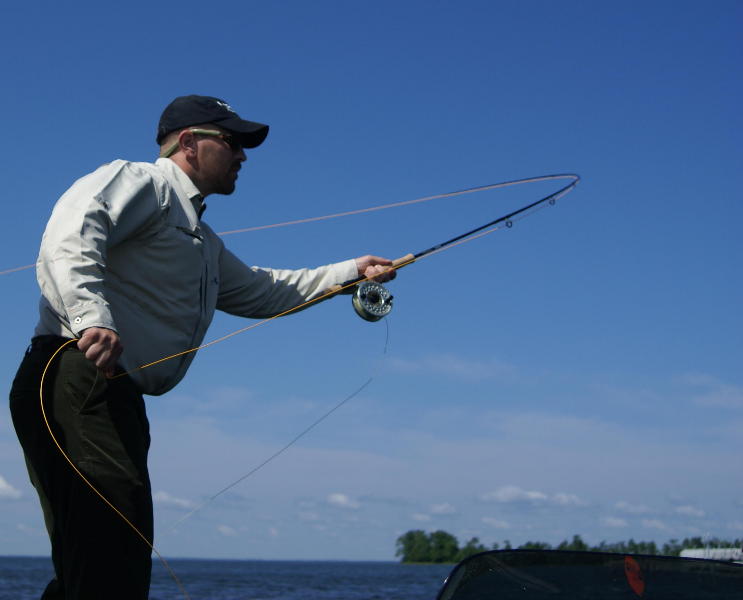|
|

Posts: 476
Location: St. John, Indiana | looking at making my own rod, i've been watching videos on mudhole.com, are there any videos you guys know on making musky rods? how do i determine what size guides to buy? | |
| | |

Posts: 910
Location: South-Central VA | I don't think you'll find anything on building musky rods. When you master the techniques needed, they apply to all rods.
As far as guides, used 1 per foot of length plus 1. For an 8' rod, you'd want 9 guides plus a tiptop. If you use the foregrip, start with a 20, if not, go with a 16 for the first guide. I usually go with a 12 next and then 8's to the tip.
jeremy | |
| | |
Posts: 994
Location: Minnesota: where it's tough to be a sportsfan! | AL at Viking Rod and Reel/ Nisswa MN has made Muskie to Ocean Rods for years. You could track him down I'm sure he would help out with information. Jake | |
| | |
Posts: 4343
Location: Smith Creek | Most will static test for placement, static testing is explained here:
http://deltacustomrods.wordpress.com/2011/11/18/guide-spacing-stati...
I like 16, 12, 10, and the rest 8's, but that's just personal preference, and on a blank that will handle 4-16 oz.
I'll downsize on lower rated blanks, 12, 10, and 7's. | |
| | |
| If considering building a custom rod, I HIGHLY recommend you consider a spiral-wrapped rod. You will be amazed at how enjoyable it is to fish with a casting rod where the lever arm effect of having guides on top of a blank have been eliminated (because the guides quickly transition to underneath the blank). This in no way hinders casting ability, but greatly improves the rods stability when a heavy load is applied, such as when fighting a large fish.
When I do a consultation with a customer, I generally start with a lighter and longer blank than what the customer thinks they want, but with a similar action. I then string up a couple of their favorite baits on a two foot lead, the end having a loop to place over the blank. The loop is slid up and down the blank tip and fixed with tape to determine the best feel the angler wants. This is their call. Each bait is marked on the blank tip for it's ideal point. Then the points are reviewed and a final cut point is decided upon. This trimming establishes the exact power YOU feel is correct from a blank, not what is listed in a catalog (that is just a general guideline that varies from MFG to MFG). Once the tip is cut, a measurement is made to set the length of the rod and then the butt is cut. This gives you your blank to build upon.
Keep in mind that to build a great rod from this point, you want to keep weight at an absolute minimum. Unfortunately, light weight usually costs money, but it's worth it in the long run, especially on rods that tend generally to be unwieldy. This means small light guides, as small as you can use to pass your line and splices, etc without restriction. Keep in mind that more but smaller guides is generally better than fewer larger guides.
Keep the amount of thread at a minimum, and use finish sparingly; excess thread and finish, anything more than just enough, detracts from the performance of your rod.
Static load testing a musky blank can be challenging as they are quite stiff; make sure to flex the blank throughout the area where the rod will be loaded lightly through to very heavily. If you are using a levelwind reel with a spiral wrap, make sure to position the stripper guide so the LINE is CENTERED down the blank, not the guide ring. This will prevent line building to one side of the spool if a lot of line is removed from the reel and re-wound fighting a fish.
Try three guides total to transition from top to bottom, (approx -5, 90, and 180 degrees). If you ever lay your rod on a deck, spiral the guides to the same side as your reel's handle; this will place the transition guides upwards and the blank will rest on the deck. If you reverse this, your guides will be down and unacceptable to damage much more easily.
Consider using a Fuji PSSLD trigger seat (it has a different trigger position that traditional trigger seats). To keep weight to a minimum, consider using Titanium framed guides (expensive). If that is too expensive, consider using Titanium for some guides instead of them all; you get the best gang for your buck in rod performance by minimizing guide weight from the tip rearward - especially those guides mounted where the blank does most of the flexing)
I hope these general guidelines help you understand the planning parts that the "how-to" you tube videos don't cover. They are pretty good at covering the actual assembly steps, but horrible at covering the why you do something vs something else aspects. Without really understanding the big picture, it's unlikely you can build a ferrari by going to autozone and buying random parts off the shelf. Your local custom builder is the engineer that should be able to help you come up with the right parts, and assembled in a way, to meet your very specific desires.
I tell people, if your just gonna slap something together without really understanding the how and why, you're generally better off buying a premium factory rod where someone with rod assembly knowledge put the thing together. It won't have the bling like a custom can have, but at least it will function well. | |
| | |

Posts: 283
| Where do you find the best source for parts (quality and affordability)? | |
| | |
Posts: 4343
Location: Smith Creek | Angler's Workshop out west, Mudhole out east, Thornes in the midwest. | |
| | |

Posts: 1663
Location: Kodiak, AK | I get everything from Angler's. | |
| |
|
 rod building
rod building rod building
rod building